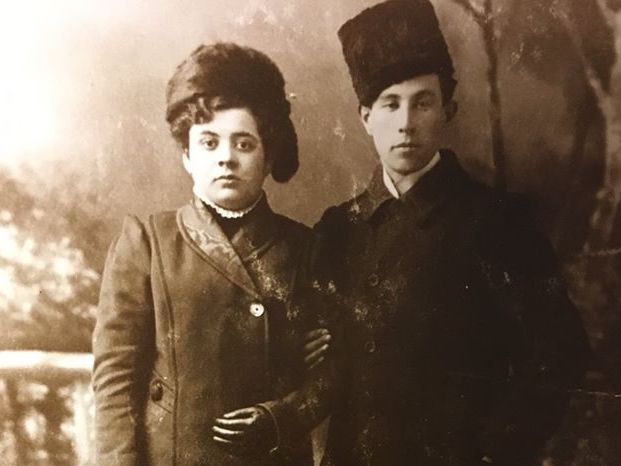20th Century Romance
Nathan was born in the 1880’s, one of five siblings, four boys and one girl. He grew up in the Russian shtetl of Krasne, in what is now Belarus. The family was poor. Nathan’s father died when he was five. His two older brothers tried to support the family. They had few material goods and no opportunities for a formal education.
Goldie, also from Kasne, was born two years later than Nathan. She had a brother and a sister. Their father owned a prosperous business, and the family was considered “middle class.” They did not mix with the poorer Jewish families in town.
Nathan was sent to Odessa at the age of 14 to work for his uncle. He learned bookkeeping and penmanship. When the uncle died, Nathan returned to Krasne. His mother and sister were dead, and the older brothers had emigrated to America. Shortly thereafter, the youngest brother, Louis, emigrated. Nathan stayed behind to settle the family affairs. He was 18 years old.
Being a very practical and resourceful young man, Nathan knew there was no future for him in Russia. He made plans to emigrate like his brothers. Then, he met 16-year-old Goldie. It was love at first sight.
Goldie’s parents were horrified. This poor Jew, who had nothing and came from nothing, wanted to marry their daughter. When they learned Nathan was planning to emigrate, they feared Goldie would run off with him! They locked her in the house!
Nathan left Krasne and came to the US through Ellis Island. He lived with relatives in New Haven and learned English and a trade–plumbing. The search for work took him West where his three brothers had settled. Eventually, he and two brothers found work in South Dakota. The land and climate reminded him of Russia.
Nathan acquired a homestead on the prairie. No indoor plumbing in his sod hut! He even had a horse. The closest neighbors were miles away.
In 1917, the US entered World War I, and Nathan enlisted in the Army. He was sent to Paris but fortunately never saw combat. After his discharge, he earned his US citizenship and went back to South Dakota, settling in the town of Sioux Falls. It was then time to get Goldie!
Below is his journey, taken from his “Soldier’s Diary and Note Book.”
Journey to Europe:
- Nov. 8, 1920, left for Europe (from Sioux Falls)
- Nov. 12, left Chicago
- Nov. 15, left Cleveland (brother Isadore lived there)
- Dec. 7, visited New York and Jersey City
- Dec. 8, went to New Haven
- Dec. 14, left on Aquitania for Cherbourg
- Dec. 19, came to Cherbourg at 6 pm and left at 8 pm
- Dec. 20, came to Paris, at Hotel Anglo Americain
- Dec. 27, left Paris for Cologne
- Dec. 28, came to Cologne, left for Berlin
- Dec. 29, came to Berlin, Stentel, and Bentchlen
- Dec. 30, left Bentchlen, came to Posen
- Dec. 31, came to Warsaw
- Jan 4, 1921, left Warsaw
- Jan 5, came to Wilno
- Jan 25, left Wilno for Krasne
- Jan 26, came to Krasne
Journey back to the U.S.:
- Feb. 9, 1921, visited Molodechno (12 miles from Krasne)
- Feb. 11-21, came to Wileiky. (Nathan’s father was from this town; his uncle Nochim was alive and lived there.)
- Feb. 17, went to Wilno.
- Feb. 22, came to Warsaw. Got married.* Left March 12
- March 13, came to Bentchlen, left for Berlin, arrived Berlin
- March 14, left Berlin, came to Cologne
- March 15, left Cologne, came to Brussels at 5 pm. Left Brussels 10:30 pm
- March 16, came to Paris 7:00 am. Left Paris March 16, 9:00 p.m.
- March 17, came to Cherbourg 7:00 a.m.
- April 2, left Cherbourg
- April 9, came to Hoffman Island. (This was a quarantine station. Gladys, Goldie’s sister who came with them, had chickenpox or another illness upon arrival)
- April 11, left Ellis Island
- April 24, left New York for Syracuse
- April 25, arrived Syracuse (Nathan’s maternal first cousins lived there)
- April 28, left Syracuse for Cleveland
- April 28, arrived in Cleveland
- May 1, left Cleveland
- May 2, arrived Chicago, left for Sioux Falls
- • May 3, arrived Sioux Falls 11 a.m.
Nathan built a house in Sioux Falls (with indoor plumbing!). He and Goldie raised four children there. All four received the college education he could never have. Nathan and his two brothers opened several businesses over the years, including a department store. After Prohibition, they acquired a wholesale liquor license, one of two in the state.
Goldie was a proud wife and homemaker. Nathan was proud to be a US citizen and a veteran. He was an avid Democrat (and there weren’t many in South Dakota). He joined the NAACP, many veterans groups and was active in local and state politics. During World War II, Sioux Falls was home to a large Army/Air Force base. Nathan and Goldie hosted many Jewish soldiers who trained at the base.
Nathan’s devotion to Goldie was evident during the illness that took her life in the early 1960s. He sought the best medical treatment for her, including consulting physicians at the Mayo Clinic. After her death, he stayed in Sioux Falls, even though none of his children lived there. He loved his house, his town, his neighbors, and they loved him. He died at the age of 89 and had a a military funeral with a large write-up in the local newspaper, The Argus Leader.
If you haven’t yet guessed, Nathan and Goldie are my (maternal) grandparents. Their inscribed gold wedding bands rest in my jewelry box.
*Nathan and Goldie were married twice! The first wedding in Russia was not recognized by the US Embassy in Warsaw. They found a rabbi in Warsaw who remarried them. The photo of them was taken in Warsaw at their second wedding.


I just sent this photo to my son, English name Nathan.